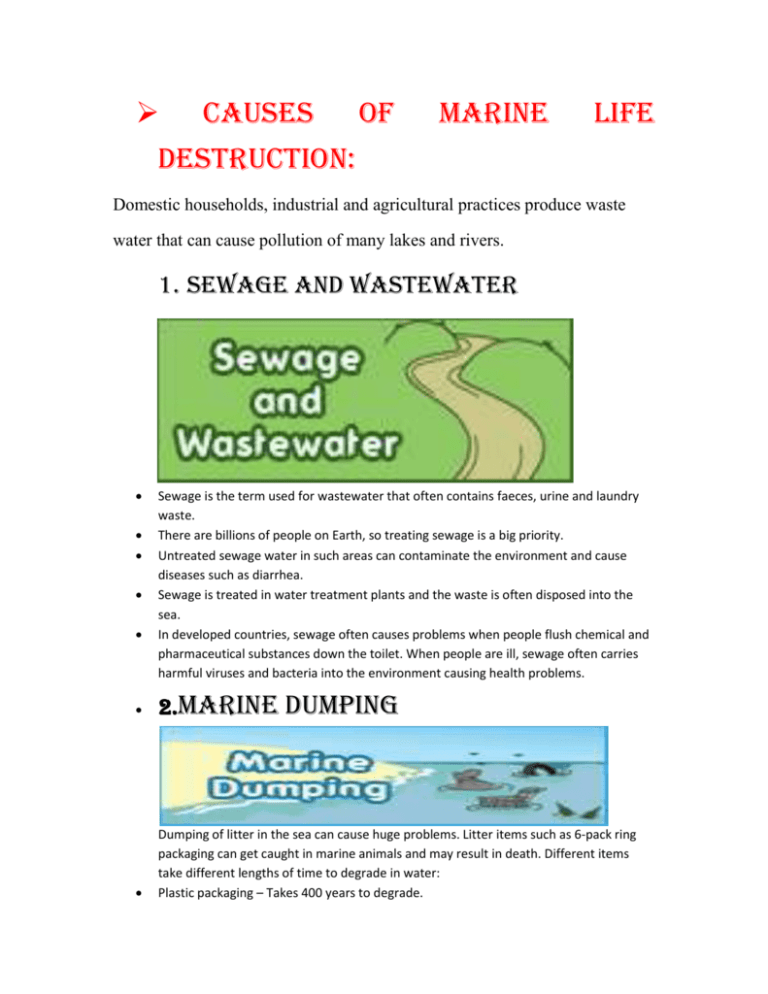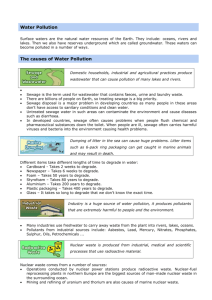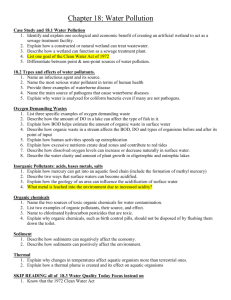Causes of destruction
advertisement

CAUSES Of Marine life destruction: Domestic households, industrial and agricultural practices produce waste water that can cause pollution of many lakes and rivers. 1. SEWAGE AND WASTEWATER Sewage is the term used for wastewater that often contains faeces, urine and laundry waste. There are billions of people on Earth, so treating sewage is a big priority. Untreated sewage water in such areas can contaminate the environment and cause diseases such as diarrhea. Sewage is treated in water treatment plants and the waste is often disposed into the sea. In developed countries, sewage often causes problems when people flush chemical and pharmaceutical substances down the toilet. When people are ill, sewage often carries harmful viruses and bacteria into the environment causing health problems. 2.MARINE DUMPING Dumping of litter in the sea can cause huge problems. Litter items such as 6-pack ring packaging can get caught in marine animals and may result in death. Different items take different lengths of time to degrade in water: Plastic packaging – Takes 400 years to degrade. Newspaper – Takes 6 weeks to degrade. Aluminium – Takes 200 years to degrade. Foam – Takes 50 years to degrade. Glass – It takes so long to degrade that we don’t know the exact time. 3. INDUSTRIAL WASTE Industry is a huge source of water pollution, it produces pollutants that are extremely harmful to people and the environment. Many industrial facilities use freshwater to carry away waste from the plant and into rivers, lakes and oceans. Pollutants from industrial sources include: Sulphur – This is a non-metallic substance that is harmful for marine life. Oils – Oil does not dissolve in water, instead it forms a thick layer on the water surface. This can stop marine plants receiving enough light for photosynthesis. It is also harmful for fish and marine birds. Petrochemicals – This is formed from gas or petrol and can be toxic to marine life. Nitrates – This can cause eutrophication, which can be very problematic to marine environments. Phosphates -This can cause eutrophication, which can be very problematic to marine environments. ATMOSPHERIC pollution 4. Atmospheric deposition is the pollution of water caused by air pollution. In the atmosphere, water particles mix with carbon dioxide sulphur dioxide and nitrogen oxides, this forms a weak acid. Air pollution means that water vapour absorbs more of these gases and becomes even more acidic. When it rains the water is polluted with these gases, this is called acid rain. When acid rain pollutes marine habitats such as rivers and lakes, aquatic life is harmed. HARMFUL EFFECTS DUE TO DESTRUCTION OF MARINE LIFE Water Pollution Introduction Water pollution is a major problem in the global context. It has been suggested that it is the leading worldwide cause of deaths and diseases,and that it accounts for the deaths of more than 14,000 people daily. Water pollution is the contamination of water bodies (e.g. lakes, rivers, oceans, groundwater). Water pollution affects plants and organisms living in these bodies of water; and, in almost all cases the effect is damaging either to individual species and populations, but also to the natural biological communities. Water pollution occurs when pollutants are discharged directly or indirectly into water bodies without adequate treatment to remove harmful compounds Ingestion-Marine animals often mistake many man-made pollutants for food. Animals will either choke on the pollutants or ingest the pollutants and die. Plastic bags commonly cause this problem. Entanglement-Ordinary items such as plastic, six-pack soda can holders and fishing line are harmful pollutants to marine wildlife. They can ensnare marine animals, effecting their ability to move, breath and eat. If the animals cannot release themselves from the pollutants, they may starve or drown. Productivity-Certain chemicals, such as plant fertilizer, greatly increase an organism's ability to reproduce. When these pollutants are introduced to marine ecosystems they trigger an increased production or bloom of certain organisms. This can especially lead to algae blooms, such as red tide. Blooms must consume more nutrients and oxygen from the water, leading other organisms to starve or drown.








